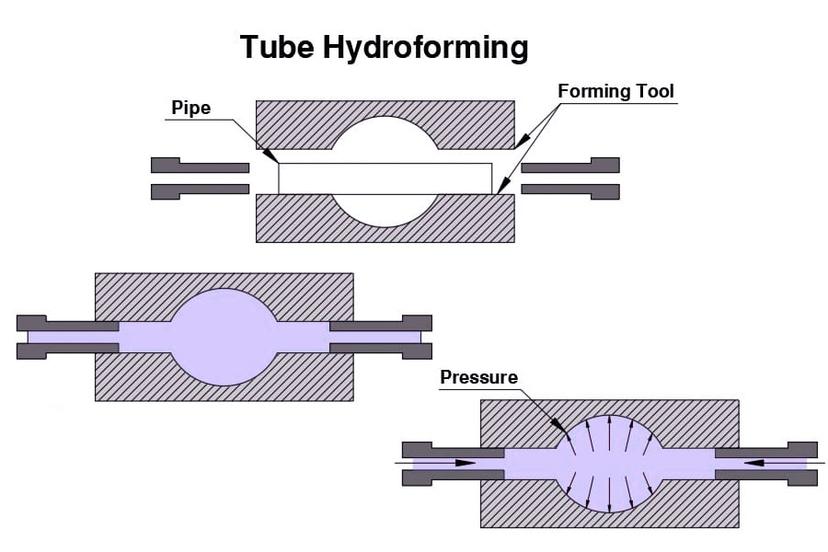In today's highly industrialized society,metal forming technology plays a vital role. From precision components in aerospace to complex structural parts in automobile manufacturing, every advancement in metal forming technology promotes the rapid development of related industries. Among many metal forming technologies,hydroforminghas gradually become an indispensable part of many industrial fields due to its unique advantages. In the following content, we will further explore the definition of hydroforming, the process and its applications in various fields.
What is hydroforming?
Hydroforming is a cost-effective and professional mold-forming metal fabrication and forming process that uses high-pressure hydraulic oil to form metals such as steel, stainless steel, carbon, copper, aluminum and brass into lightweight, strong and structurally sound parts. Almost any metal that can be cold formed can be hydroformed.Hydroforming can form complex shapeswith concave surfaces that would be difficult to achieve with standard one-piece die stamping.
One of the largestapplications for hydroformingis in the automotive industry, which requires complex shapes that are lighter, stronger, and stronger.
This process is also often used to form aluminum tubes for bicycle frames. Other advantages of parts manufactured via hydroforming include seamless bonding and increased part strength. They also maintain a high quality and less grainy surface for easier metal finishing.
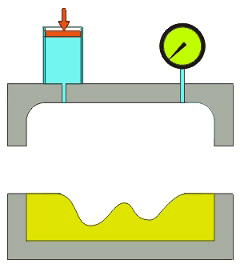
What Are the Types of Hydroforming?
Hydroforming technologycan be mainly divided into the following two types according to different molding objects and application scenarios:
1.Pipe hydroforming:
Also known as internal high-pressure forming, it is the most widely usedtype of hydroformingtechnology. It is mainly used to manufacture hollow structural parts with circular, rectangular or special-shaped cross-sections that change along the component axis. By applying ultra-high-pressure liquid to the inside of the pipe and applying axial thrust to both ends, the pipe blank material is plastically deformed and finally fits the inner wall of the mold cavity.
2.Plate hydroforming:
A plate forming method that uses liquid as a force transmission medium to transmit load and form the plate onto a single-sided mold. Suitable for the production of large sheet metal parts with complex shapes and variable sizes.Plate hydroforming technologyhas the advantages of low mold cost, short manufacturing cycle, and high forming limit.
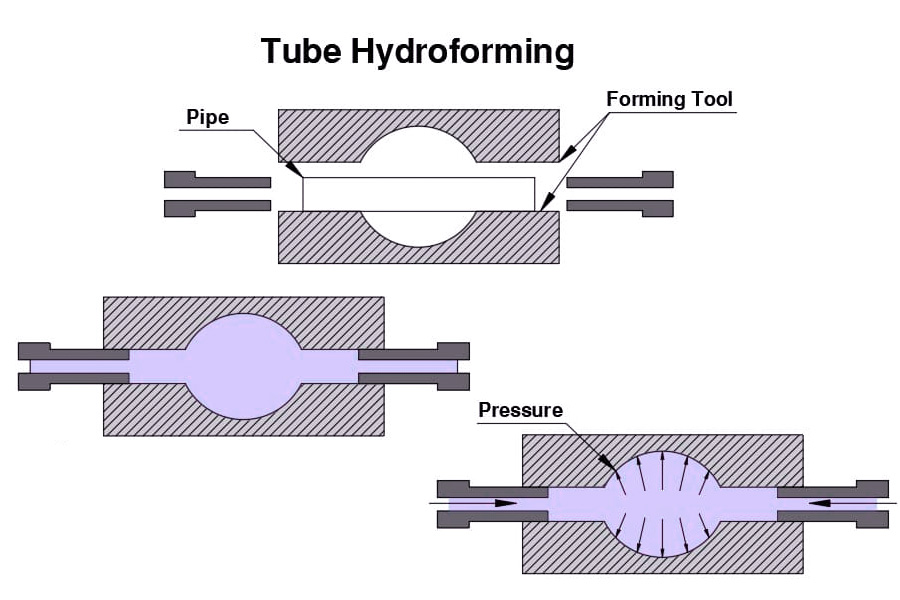
How Does the Hydroforming Process Work?
Hydroforming is a manufacturing processthat uses liquid pressure to plastically deform a workpiece. How it works can be summarized as follows:
- Preparation Phase:Place the workpiece to be formed (such as tubes, plates, etc.) in the mold, and ensure the tightness between the workpiece and the mold. Depending on the need, a certain preload or clamping force is applied to the workpiece to maintain its stability during the forming process.
- Liquid filling stage:Liquid (such as water, oil, etc.) is filled into the mold or inside the workpiece by means of a hydraulic pump or other pressure device. The liquid creates a certain pressure inside the mold or workpiece in preparation for the subsequent molding process.
- Forming stage:Continue to apply liquid pressure to the inside of the mold or workpiece, so that the workpiece will be plastically deformed under the action of pressure. The workpiece gradually fits into the cavity of the mold to form the desired shape and size. In this process, the pressure of the liquid is evenly distributed, so that the uniformity and precision of the workpiece forming can be ensured.
- Decompression and removal phase:When the workpiece has reached the desired shape and size, the liquid pressure is stopped. Remove the liquid pressure inside the mold or workpiece and remove the molded workpiece. The workpiece is subjected to the necessary post-processing, such as cutting, trimming, etc., to meet the final use requirements.
What are the advantages and disadvantages of hydroforming?
There are manybenefits to using hydroformingas a metal fabrication process, including:
| Advantages | Hydroforming |
|---|---|
| Quality and material savings | Hydroformed parts are usually 20%~40% lighter than traditional stamping parts, saving materials |
| Molds quantity and cost | Hydroformed parts usually only need one set of molds, which reduces the number of molds and costs |
| Post-processing and assembly | It can reduce the amount of welding required for subsequent machining and assembly, and improve production efficiency |
| Strength and stiffness | Improve the strength and stiffness of molded parts, especially fatigue strength |
| production costs | The production cost of hydroformed parts is reduced by 15%~20% on average compared with stamped parts |
| flexibility | It is suitable for workpieces with various complex shape and size requirements, and the process is highly flexible |
| Mold life | The mold manufacturing is simple, the production cycle is short, and the mold life is long |
| Scope of application | It can process product parts with complex shapes, such as bellows, rocket engine parts, etc |
Like any other metal forming technology,hydroforming has its drawbacks, although these are minor.
| Disadvantages | Hydroforming |
| Operational complexity | The operation process is more complex than that of general steel molds and rubber molds, which requires professional equipment and technology |
| Risk of defects | In tube hydroforming, the most common defects are bending, beryllium, and cracking |
| Control the difficulty | Parameters such as liquid pressure, loading mode, loading size, etc., need to be precisely controlled |
| Investment in equipment | It requires high equipment costs, including hydraulic pumps, molds, etc |
| Applicability Restrictions | For some specific shapes and materials, special processes and equipment may be required |
What Are the Key Applications of Hydroforming?
Hydroforming technology is widely used in many fieldsbecause of its unique advantages. The following is a specific summary of the application fields of hydraulic forming:
1. Aerospace
Hydroforming technology is mainly used in the aerospace fieldto manufacture various complex-shaped parts and structural parts, such as bellows, fairings, aircraft doors, wing ribs, etc. These parts usually require high strength and rigidity, and at the same time require weight reduction to meet the lightweight and high-performance needs of aerospace vehicles. Hydroforming technology can meet these requirements well and has therefore been widely used in the aerospace field.
2. Automotive
In the field of automobile manufacturing,hydroforming technology is mainly used to manufacture body structural parts, chassis parts, engine brackets, etc. These parts are often complex in shape and require high strength and rigidity while reducing weight to improve fuel economy and vehicle performance. Hydroforming technology can efficiently produce these parts and meet the requirements of lightweight, high strength and high rigidity, so it has been widely used in automobile manufacturing.
3. Household
In the field of household appliances,hydroforming technology is mainly used to manufacturevarious parts and components with complex shapes, such as the inner barrel of a washing machine, the shelves of a refrigerator, and the fan blades of an air conditioner. These parts usually require good forming accuracy and surface quality, and at the same time require weight reduction to reduce production costs and improve performance. Hydroforming technology can meet these requirements and is therefore widely used in the field of household appliances.
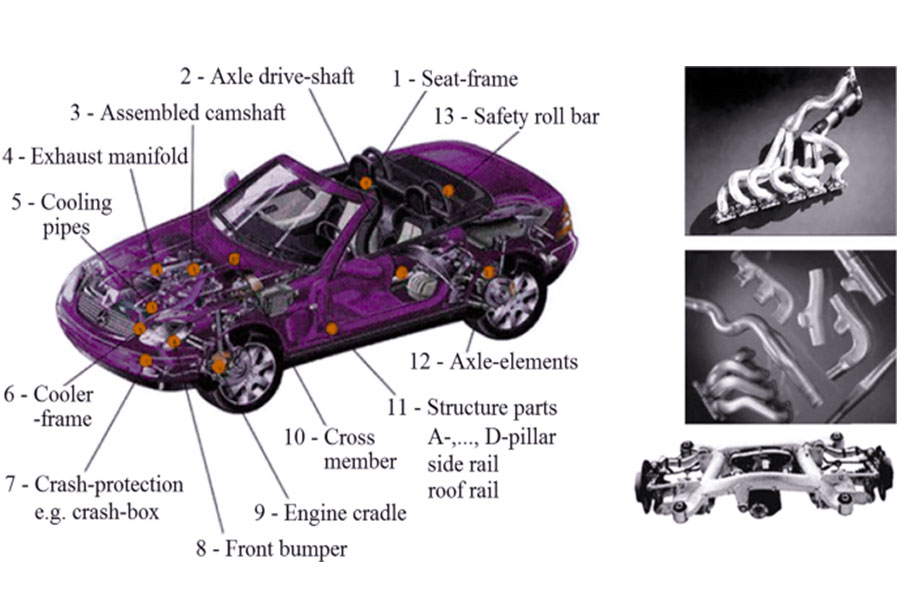
What Materials Are Used in Hydroforming?
Hydroforming technology is an advanced plastic processing technologythat uses high-pressure liquid as a force transmission medium to form workpieces. Here are some materials suitable for hydroforming:
1.Sheet metal:
- Steel plate:It has good strength and ductility and is suitable for manufacturing various automobile parts, building structures and mechanical parts.
- Aluminum plate:low density, high strength, good corrosion resistance, suitable for aerospace, automotive and electronic equipment and other fields.
- Stainless steel plate:With excellent corrosion resistance and high temperature resistance, it is suitable for fields such as food processing, medical equipment and chemical industry.
2.Pipe material:
- High-strength steel pipes:used to make structural parts of cars and aircraft, such as bumpers, frames, and fuel tanks.
- Aluminum alloy tube:lightweight, high strength, suitable for aerospace and automotive fields.
- Stainless steel pipe:corrosion-resistant, high-temperature resistant, suitable for chemical, petroleum and natural gas industries.
3.Plastics:
- Thermoplastics:such as polyethylene (PE), polypropylene (PP), polyvinyl chloride (PVC), etc., can be used to make various decorative parts, packaging materials and building materials throughhydroforming technology.
4.Rubber:
It has good elasticity and sealing properties and is suitable for manufacturing seals, shock absorbers and tires.
5.Composite material:
It is composed of two or more materials with different properties and has the characteristics of high strength, high modulus, corrosion resistance and fatigue resistance. Suitable for aerospace, automotive and high-end manufacturing fields.
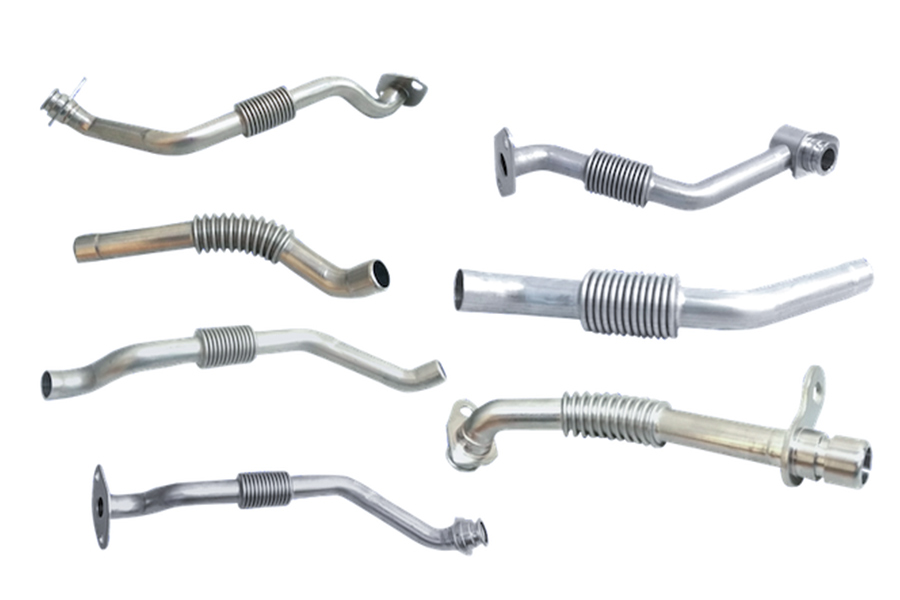
FAQs
1.What is hydroforming?
Hydroforming, also known as hydroforming, is a plastic processing technology. It uses high-pressure liquid as the force transmission medium to plastically deform the material in the mold, thereby obtaining the workpiece of the required shape and size. Hydroforming technology is widely used in automotive, aerospace, electronics, medical and other fields, and is especially suitable for manufacturing parts with complex shapes and high dimensional accuracy requirements.
2.What is the hydroforming process?
The hydroforming process is an advanced plastic processing process that uses high-pressure liquid as a force transmission medium to plastically deform metal or non-metallic materials in the mold, thereby obtaining workpieces of the required shape and size. This process has the advantages of simple mold making, short cycle, and low cost, and is especially suitable for the production of small batches and multiple varieties of complex parts.
3.What is the process of hydraulic forming?
The hydroforming process usually includes the following stages: Filling stage: Place the pipe or plate in the mold and inject high-pressure liquid to fill the material with liquid and eliminate gas. For pipes, it is usually necessary to seal both ends of the pipe with a horizontal punch. Forming stage: By increasing the pressure of the liquid, the material is plastically deformed in the mold and gradually conforms to the shape of the mold. This stage may require controlling parameters such as liquid pressure, flow rate, and mold clamping force. Shaping stage: After the forming stage, the pressure of the liquid is further increased to shape the workpiece to ensure its dimensional accuracy and shape stability. There is basically no feeding at this stage. From the cross-section perspective, the pipe can be changed into a rectangular, trapezoidal, oval or other special-shaped cross-section.
4.What is the process of hydroforming deep drawing?
The hydroforming deep drawing process is an important application in the hydroforming process, especially suitable for the forming of sheet metal. The process usually includes the following steps: ① Preparation stage: Place the plate on the concave mold, and press the plate with a blank holder to form a sealed state in the concave mold cavity. At the same time, the hydraulic chamber is filled with liquid medium. ②Drawing stage: The punch begins to move downward and enters the concave die, and the liquid medium in the liquid-filled chamber builds up pressure through natural pressurization or a hydraulic system. Liquid pressure acts on the sheet, causing it to press against the punch and gradually take shape. ③Maintenance stage: During the deep drawing process, a certain liquid pressure and blank holder force need to be maintained to ensure that the sheet can smoothly fit into the shape of the punch. At the same time, the liquid overflows from the surface of the plate and the die to form fluid lubrication, which facilitates the entry of the plate into the die and reduces surface scratches on the parts.④Removal stage: When the deep drawing process is completed, lift the punch and blank holder, and take out the formed parts. The parts obtained at this time usually have high accuracy and surface quality.
Summary
As an advanced plastic processing technology, hydraulic forming technology has the advantages of low mold cost, high forming limit, good surface quality, high material utilization rate and high production efficiency. It is widely used in automobiles, aerospace, electronics, medical and other fields, and has made important contributions to the development of the manufacturing industry. With the continuous advancement and innovation of technology, hydraulic forming technology will be applied and promoted in more fields.
Disclaimer
The content on this page is for reference only.LSdoes not make any express or implied representation or warranty as to the accuracy, completeness or validity of the information. No performance parameters, geometric tolerances, specific design features, material quality and type or workmanship should be inferred as to what a third party supplier or manufacturer will deliver through the Longsheng Network. It is the responsibility of the buyerseeking a quote for partsto determine the specific requirements for those parts.Pleasecontact usfor moreinformation.
LS Team
LS is an industry-leading companyspecializing in custom manufacturing solutions. With over 20 years of experience serving more than 5,000 clients, we focus on high-precisionCNC machining,sheet metal fabrication,3D printing,injection molding,metal stamping,and other one-stop manufacturing services.
Our factory is equipped with more than 100 advanced 5-axis machining centers and is ISO 9001:2015 certified. We provide fast, efficient, and high-quality manufacturing solutions to customers in over 150 countries worldwide. Whether it’s low-volume production or large-scale customization, we can meet your needs with delivery as fast as 24 hours. ChoosingLS Technologymeans choosing efficiency, quality, and professionalism.
To learn more, please visit our website:www.lsrpf.com



